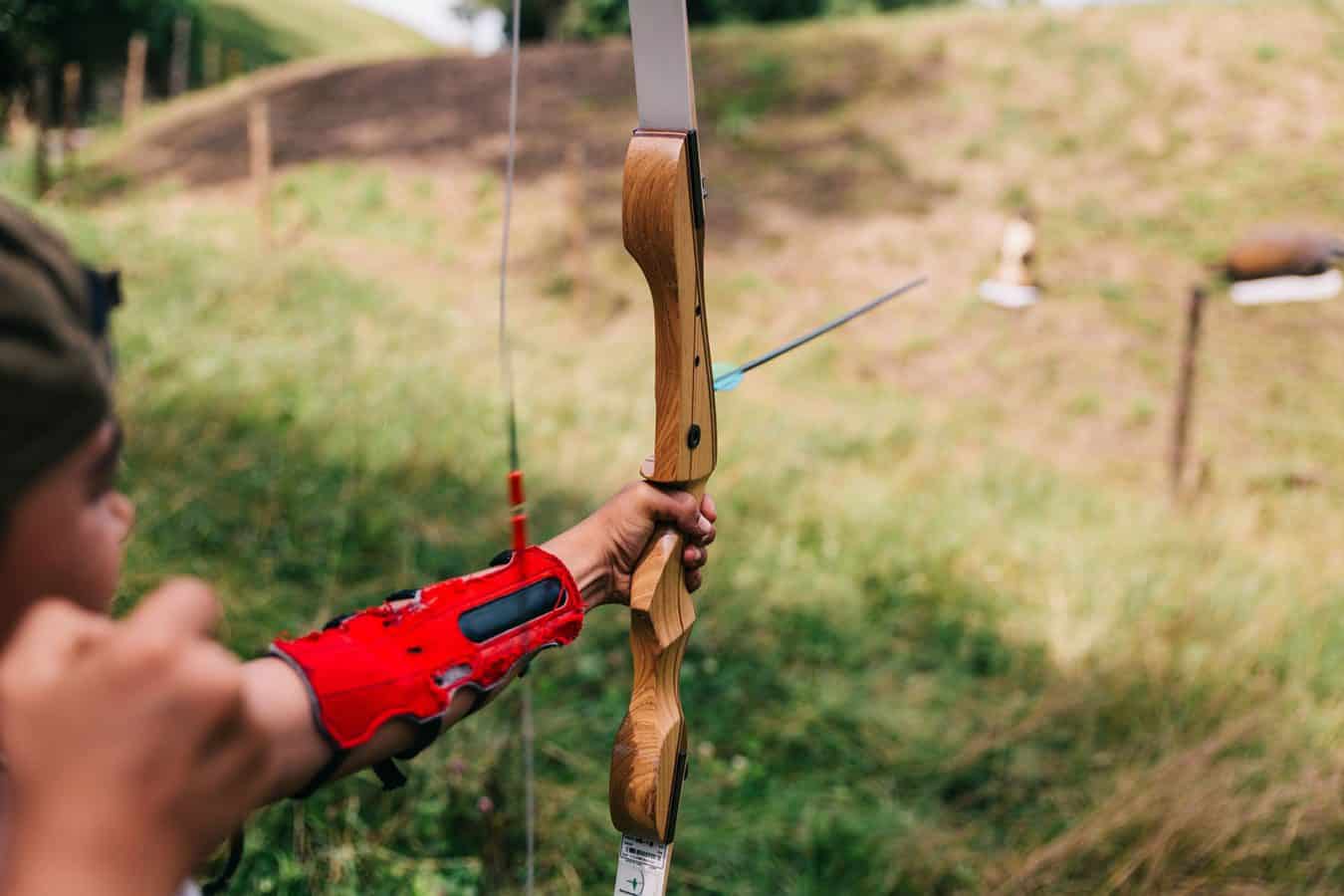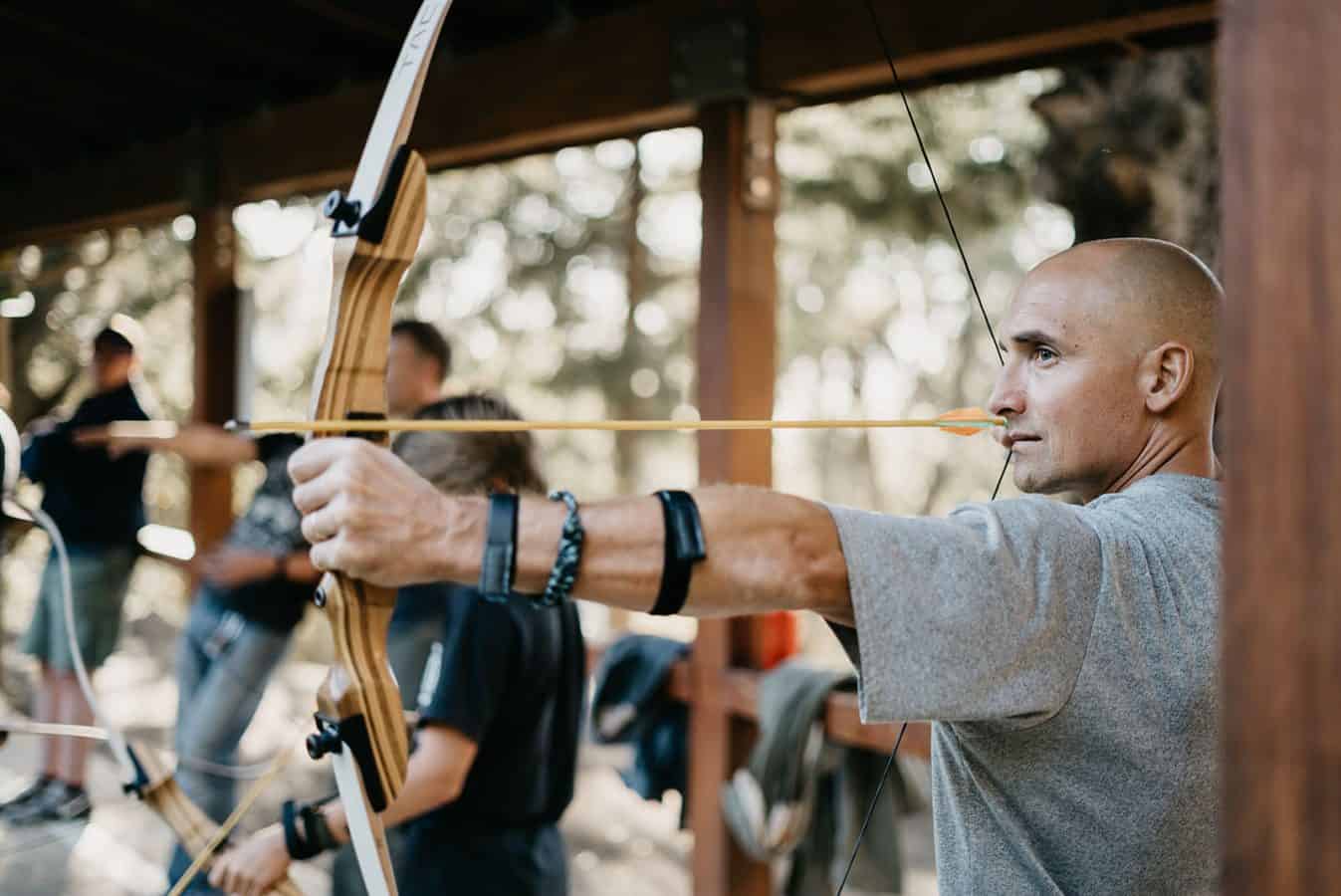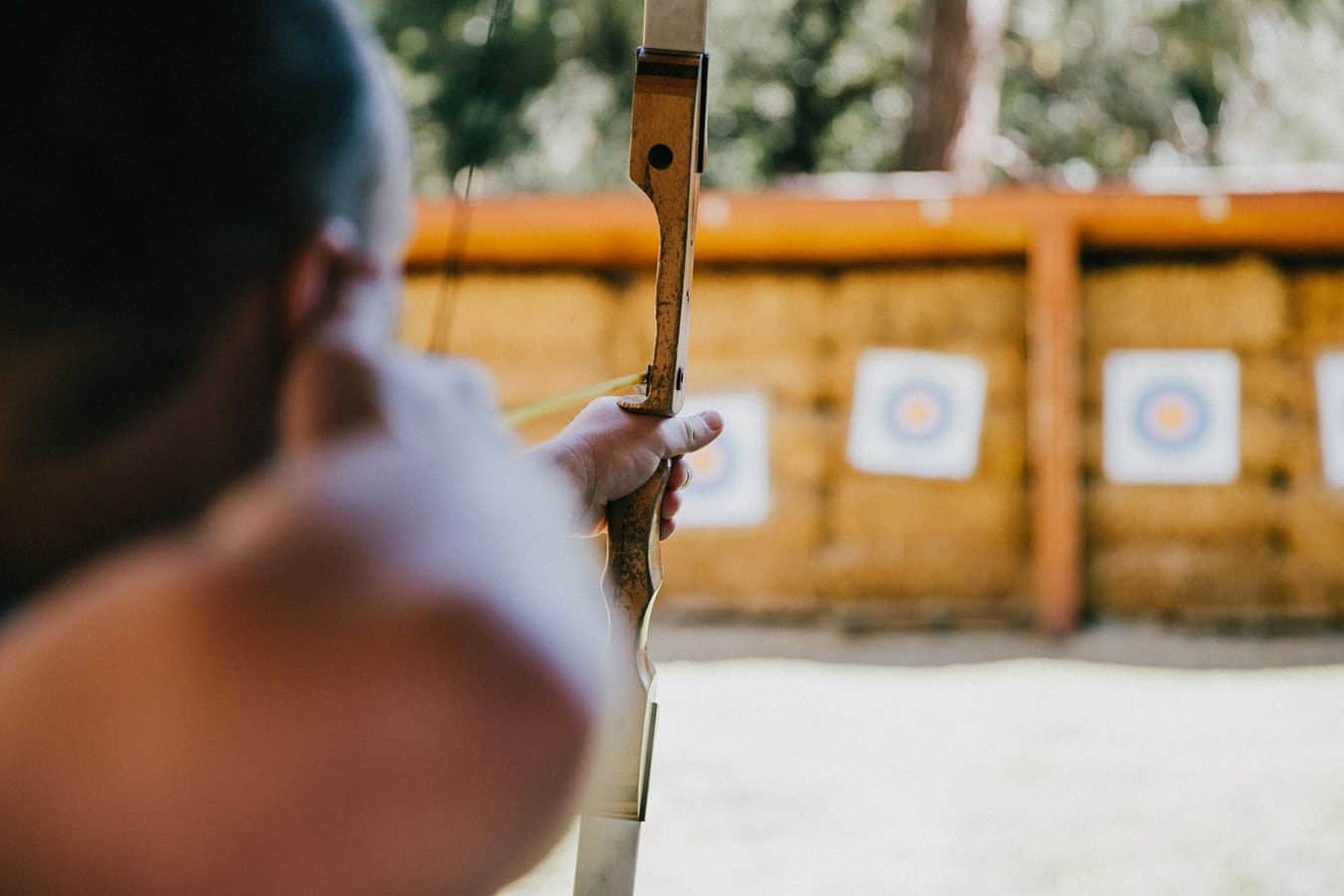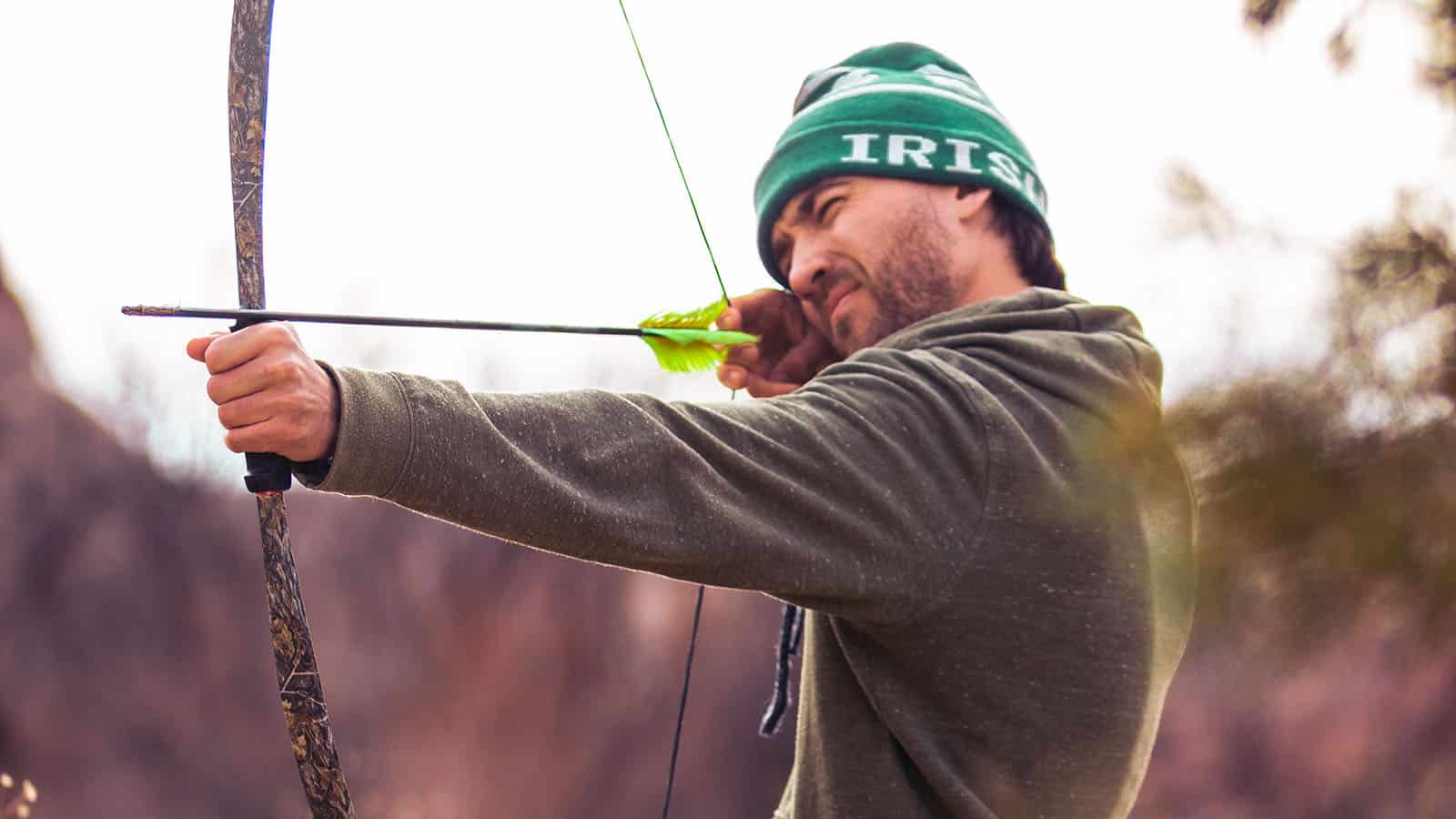How to Aim a Bow Without Sights
Instinctive archery is a means of traditional archery where you shoot and aim a bow without sights. To be a pro at instinctive archery, you need a consistent shot sequence which includes:
- Proper bow set-up
- Proper stance
- Checking your bow grip
- Nocking your arrow
- Raising your bow
- Checking your draw hand grip
- Drawing your bow to an anchor point
- Releasing your arrow
- Staying still until your arrow hits the target
Among the archery community, there is a renewed interest in traditional archery. That is, some archers are abandoning their modern bowhunting gear. They use a bow without sights, stabilizer, scopes, or other gear and accessories.
Instead, they are falling back on instinctive archery. Today, we dive deep into the topic of instinctive archery. At the end of this step-by-step tutorial you will be able to begin your instinctive archery journey and learn how to aim a bow without sights.
What is Instinctive Archery?

Instinctive archery is a method of shooting that has been used by medieval archers in Europe, Native Americas in the Americas and the Ninja of feudal Japan. It is thus believed to be the origin of archery.
It refers to a shooting technique in which you can shoot your arrows perfectly without consciously aiming. This is done without the aid of any aiming systems or mechanisms. All that remains is the archer, his bow and arrow. Normally, archers who engage in instinctive bow shooting shoot a recurve bow, a traditional wooden bow, or a longbow.
But rather than aiming your bow, instinctive archery requires you to be confident with your senses. Because you do not specifically aim at a target per se, you have to know from experience where your arrow is going to fly when you release. This takes years and years of practice.
A huge part of instinctive archery relies on your muscle memory. By shooting hundreds of arrows from the same spot, you will build muscle memory and develop an instinct for each distance.
Over time, the goal is that you can achieve instinctive bow shooting accuracy. You learn the arc of the arrow at varied distances, and are able to visualize the shot in your mind. This way, you can instinctively repeat shots purely by the feel of each shot.
Why Practice Instinctive Archery?
It will take many shots and a long time for one to master instinctive archery. Therefore, it can be extremely frustrating for those who are just picking it up. So much so that many archers argue that it makes so much more sense to aim a compound bow, a longbow or a recurve.
But when you do master the techniques of instinctive shooting, you will find that it can be satisfying and calming. At the same time, it is a very useful method. Equipped with just a bow and an arrow, you can have a deadly method of shooting.
With precise movement and skills, you will become a faster hunter. It is also rewarding to know that with just your experience and instincts, you are able to shoot an arrow accurately to the target.
Types of Instinctive Archery
Gap shooting
The first style of instinctive archery is gap shooting, where you line the point of the arrow up with the target and judge distance. This style uses the point of the arrow, as if it was a sight.
While some may argue that gap shooting is not exactly instinctive, many archers argue otherwise. They subscribe to the notion that gap shooting can become instinctive over time. This happens when the archer has learned his gap so well that he no longer has to think about it. He can aim subconsciously through the many hours of repetition and practice.
Over the course of several practice shots, you determine where your ideal range is. This is the range where you will hit the target perfectly while aiming directly at it. From there, you will begin to learn how far down or over the target you should aim. This depends on how far or near the target is from you.
In gap shooting, there is something that archers call “point on”. When you are point on, you are said to be standing at the correct distance to complete your shot. Each bows’ point on distance is different and you will have to find to figure out the point on spot, by shooting and moving further or closer to the target.
When you are close to the target, you need to aim a bow and arrow lower. On the contrary, if your target is far away, you should aim your arrows higher!
See and Shoot
The see and shoot method of instinctive archery is basically what its name states: you look at a target and shoot with no conscious aiming in mind. This instinctive aiming method is often likened to throwing a ball. When you throw a ball, you simply throw it with the thought that it would generally go where you would like it to go.
This style of archery is also often dubbed the purely instinctive style of shooting. It requires a lot more practice than gap shooting does and it can take years before your muscle memory is trained and you are able to shoot proficiently.
Things You Will Need
To follow this tutorial, you are going to need:
A bow
Your bow is your main equipment in instinctive archery. Normally, instinctive archers use a recurve bow, a traditional wooden bow, or a longbow. If you are a beginner, consider Samick Sage Takedown Recurve Bow, one of the best beginner recurve bows.
Arrows
Because the arrow is what is going to hit the target, you should consider investing in good arrows. Do consider the arrows’ spine, material, length, and many other factors when buying them. You can choose between carbon fiber, aluminum, fiberglass or wood arrows.
A target
Archery targets help you to get better at your aim. They help you to judge how accurate your shots are. If you are looking for the best archery target, consider the top-rated Rinehart Targets 18-1 Broadhead, or check out our guide here.
Practice. Lots and lots of practice.
This is the only way you will build muscle memory and develop an instinct for each distance!
Aiming a Bow Without Sights: Step-by-step Guide

1. Properly set up your bow
To allow yourself to obtain maximum accuracy and performance, ensure that your bow is set up safely and correctly based on the instructions given by the manufacturer. It is also important to make sure that the draw weight, draw length, brace height, length, as well as the weight of the bow are suitable for you.
2. Ensure proper stance
Stand with your legs positioned shoulder-width apart. Your whole body would be perpendicular to your target. This means that you need to be facing sideways to the target.
If you are right-handed, stand with your left hip pointing at the target. On the other hand, if you are left-handed, your right hip should point at the target. The balance of your weight should be between your feet and shouldn’t lean in any direction.
Keep in mind that there is no one size fits all stance that is the best for instinctive shooting. Explore around and find one that fits you the best. The most important thing for you to take note of is that you have to be comfortable and consistent with your stance such that you stand in the same way each time you shoot!
3. Check your bow grip
The key thing that you want to achieve with this step is a bow grip that ensures that you will achieve both accuracy and comfort.
To do so, hold the bow in the pad of your hand between your thumb and index finger. You bow should be lightly resting on the top of your hands: you should not be tightly gripping onto your bow. Think of it like you are gently supporting your bow. Remember, stay relaxed, but make sure you maintain a firm grip!
4. Nock your arrow
Nocking the arrow is simply the process of loading the arrow onto the bowstring. Once you nock your arrow, the nock should snap securely into place without getting loose or easily detachable from the string.
While it may seem like a foolproof step of shooting a bow, there are certain things for you to take note of when you nock your arrow as part of instinctive shooting archery. Particularly, nocking the arrow in the same spot every time you shoot is critical in instinctive archery.
5. Raise the bow
This step requires you to bring your bow up without actually drawing back the string and the arrow. Raise your bow until your arm is at shoulder height, but keep your shoulders down. Remember to maintain your stance as well as your bow grip as you raise your bow so as to ensure consistency and accuracy!
6. Use your preferred draw hand grip
Generally, you shoot by using your index, middle, and ring finger. However, there are many different draw hand grips and you should choose one that you feel most comfortable with.
You can use a Mediterranean draw, where your index finger is above and your middle and ring fingers are below, or three fingers under, where your index, middle, and ring fingers are all beneath the nock.
Learn more about methods to grasp your bow string here.
7. Draw the bow to an anchor point
An anchor point is where your bowstring and draw hands are when making a full draw. Oftentimes, this could be the corner of your mouth, cheek, or chin. Similar to the other steps in this guide, it is important to select a comfortable anchor point and stick to it to ensure consistency and accuracy in your shots when it comes to instinctive shooting.
8. Look at where you are aiming and release the arrow
For this step, you should look in the general direction of where you are shooting. This also depends on whether you are practicing gap shooting or see and shoot method.
When you release the string, it should not be an abrupt action. Instead, it should be smooth. The bowstring should slide out in a smooth motion towards the target. This way, the bow will fly in a straight motion, instead of shakily.
9. Stay still until the arrow hits the target
After shooting, you should stay still until the arrow hits the target. This is because a slight movement from you can affect the trajectory of the arrow.
Instinctive Archery Training and Tips

As we have mentioned time and again, instinctive archery requires tons of training and practice. Here are some training exercises that you can use to practice your skills for instinctive shooting.
Instinctive Archery Training Exercise
If you are just beginning your training for instinctive shooting, start small with a range of ten yards from the target. Shoot at least 20 arrows at the target. Keep doing this until you can get the arrows to group closer and closer together at the center of the target.
When you achieve that, move back to 15 yards and repeat. When you group arrows consistently at 15 yards, move back to 20 yards. Keep shooting until you can consistently group the majority of the arrows.
It would be helpful to constantly mix things up: start point shooting at various distances so that you can improve your accuracy across different distances and ranges.
Developing a Shot Sequence
Put simply, your shot sequence is all of the things that you do leading up to each shot. The consistency of your shot sequence is vital to instinctive archery. That is to say, before making every shot, you need to do all of the steps above in the exact order each time. This also entails nocking the arrow in the same spot and drawing the bow to the same anchor point.
With lots of practice, you should instinctively perform the shot sequence and it should become second nature to perform with every shot.
Conclusion
Instinctive archery may seem daunting at first, given that you have to surrender your bow sight and other modern bowhunting gear. But with the right steps and some shooting tips, you will be well on your way to shoot instinctively and aim a bow without sights!
Do you prefer aiming your bow? Or are you an advocate for traditional methods of archery like instinctive shooting? Let us know what you think in the comment section. If you learned something from this guide, be sure to share this article to your friends who are interested in archery and bowhunting!
